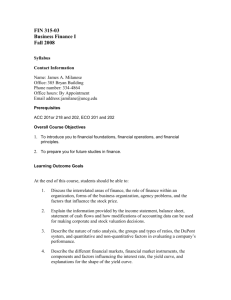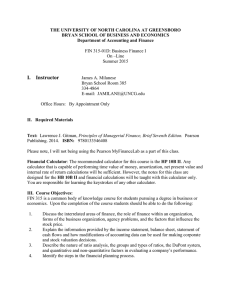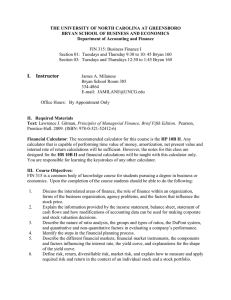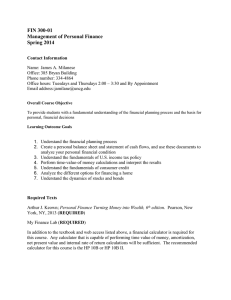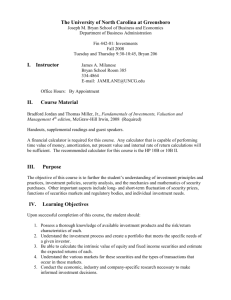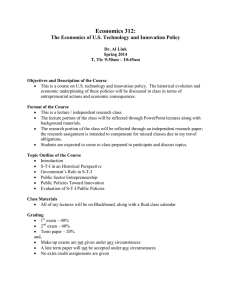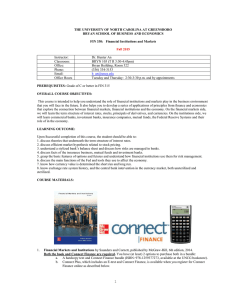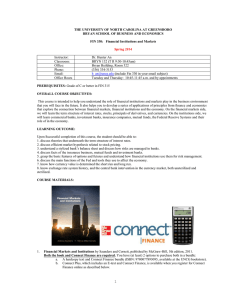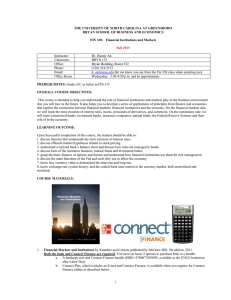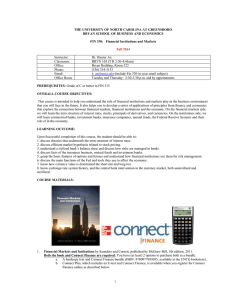FIN 315-04 Business Finance I Spring 2010
advertisement
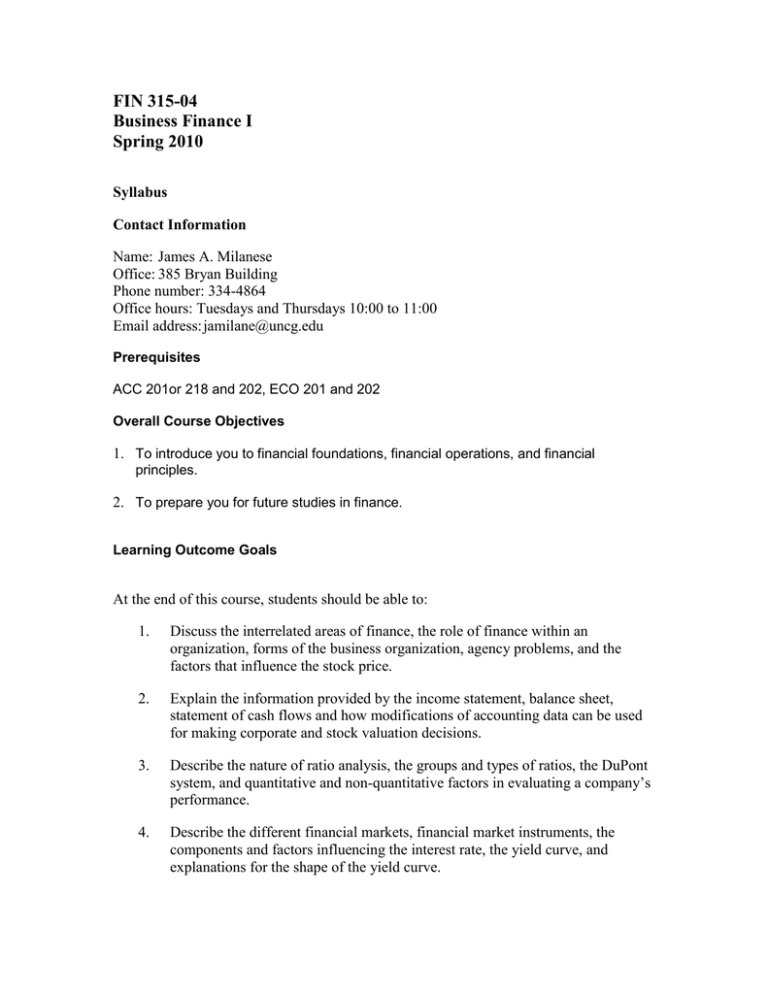
FIN 315-04 Business Finance I Spring 2010 Syllabus Contact Information Name: James A. Milanese Office: 385 Bryan Building Phone number: 334-4864 Office hours: Tuesdays and Thursdays 10:00 to 11:00 Email address: jamilane@uncg.edu Prerequisites ACC 201or 218 and 202, ECO 201 and 202 Overall Course Objectives 1. To introduce you to financial foundations, financial operations, and financial principles. 2. To prepare you for future studies in finance. Learning Outcome Goals At the end of this course, students should be able to: 1. Discuss the interrelated areas of finance, the role of finance within an organization, forms of the business organization, agency problems, and the factors that influence the stock price. 2. Explain the information provided by the income statement, balance sheet, statement of cash flows and how modifications of accounting data can be used for making corporate and stock valuation decisions. 3. Describe the nature of ratio analysis, the groups and types of ratios, the DuPont system, and quantitative and non-quantitative factors in evaluating a company’s performance. 4. Describe the different financial markets, financial market instruments, the components and factors influencing the interest rate, the yield curve, and explanations for the shape of the yield curve. 5. Define risk, return, diversifiable risk, market risk, and explain how to measure and apply required risk and return in the context of an individual stock and a stock portfolio. 6. Demonstrate how to find the present and future values of lump sums and annuities, solve for the time or interest rate in TVM problems, calculate periodic and effective interest rates, and construct a loan amortization schedule. 7. List the main classifications and characteristics of bond, calculate bond price and various bond yields, and explain the importance of bond ratings and criteria for rating bonds. 8. Identify important stock ownership rights and terms, how to value common and preferred stock, and understand stock market information in the newspaper and levels of market efficiency. 9. Explain the concept of a firm’s weighted average cost of capital, define and calculate the component costs of capital using alternative approaches, calculate the weighted average cost of capital, and identify situations when the use of the composite WACC is not appropriate. Required Texts Eugene F. Brigham and Joel F. Houston, Fundamentals of Financial Management (The Concise 6th Edition), Prentice Hall, Englewood Cliffs, NJ, 2009 (REQUIRED) In addition to the textbook listed above, a financial calculator is required for this course. Any calculator that is capable of performing time value of money, amortization, net present value and internal rate of return calculations will be sufficient. The recommended calculator for this course is the HP 10B or HP 10B II. Practice problems Each level will present practice problems for you to work through as you master the content. In addition, the Game Board and Test Your Skills exercises are for your practice and do not factor into your grade. Exams You will complete four exams. You will have one and a half hour to complete each exam. How Graded Exam 1 Exam 2 Exam 3 Cumulative Final Exam February 12 March 5 April 9 May 4 25% 25% 25% 25% Topics Covered on Each Exam Exam 1 Chapter 1: An Overview of Financial Management Chapter 3: Financial Statements, Cash Flow and Taxes Chapter 4: Analysis of Financial Statements Exam 2 Chapter 16: Financial Planning and Forecasting Chapter 2: Financial Markets, Institutions Chapter 6: Interest Rates Exam 3 Chapter 8: Risk and Rates of Return Chapter 5: Time Value of Money Chapter 7: Bonds and Their Valuation Final Exam All Material From Previous Exams plus Chapter 9: Stocks and Their Valuation Chapter 11: The Basics of Capital Budgeting Chapter 10: The Cost of Capital Your final grade will be based on the following scale: 92 – 100 90 – 91.9 88 – 89.9 82 – 87.9 80 – 81.9 78 – 79.9 72 – 77.9 A AB+ B BC+ C 70 – 71.9 68 – 69.9 62 – 67.9 60 – 61.9 Below 60 CD+ D DF Exam Guidelines 1. The exam will only be available for a 12-hour period. If it is not taken in that time period, no consideration will be given. 2. From the time you begin the exam, you will have one hour and a half to complete and submit each exam If you log-off, the clock is still running. No exam will be accepted if this time limit is exceeded. 3. You are to work independently on the exam. You may not confer with anyone about the exam. 4. You may not use anything but a calculator during the exam. Things such as books, notes, recordings or other aids are not permitted. You are to take the exam as if you were in a classroom with nothing but your pencil and calculator. Any violation of points 3 or 4 above is a violation of the UNCG Academic Honor Code and will result in an automatic grade of F in this class. In addition, formal charges will be brought against the student. Honor Policy All graded material for this class is subject to the UNCG Academic Honor Policy. If you are not familiar with this policy, please use the following link: http://www.uncg.edu/reg/Policy/HonorPolicy.html Student Disabilities: All students with a disability requesting special services must go through the Office of Disabilities Services. If you are requesting special accommodations, please bring your paper work from Disability Services directly to me the first week of class. All such information will be help in confidence. The web link to this office is http://ods.dept.uncg.edu/services/ . Challenges There are mini cases or challenges for each level. These are for the student’s benefit and are not to be handed in. Each is designed to highlight certain aspects of the material from that unit. GameBoard Exercises and Test Your Skills There are exercises and problems for each level. These are for the student’s benefit and will not factor into your final grade. Like the challenges, each is designed to highlight certain aspects of the material from that unit
